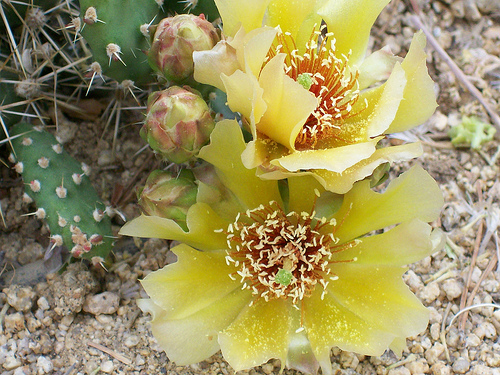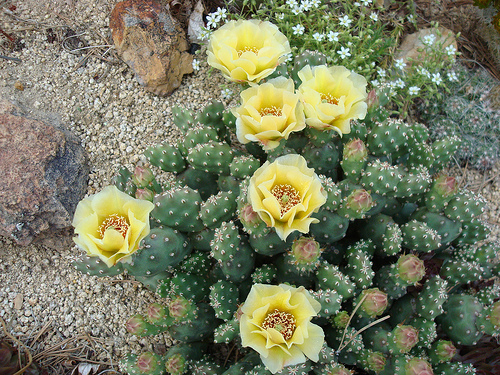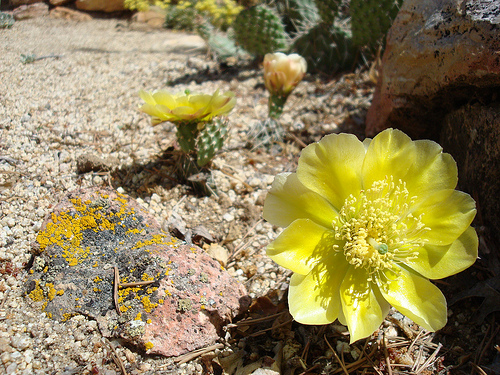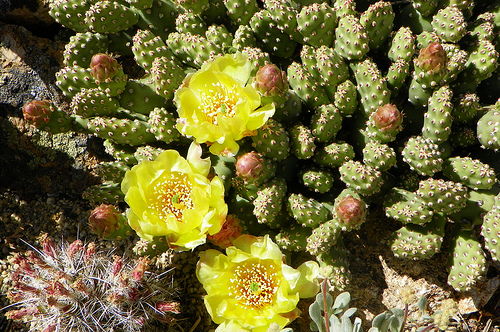The hardiest of the hardiest, and the most widely distributed of the Opuntias. Found growing in portions of 22 States, and 5 Canadian Provinces. This small mounding Opuntia is the most cold tolerant cactus in North America. It can be found growing almost to the Arctic Circle in Alberta and British Columbia.
As the scientific (Opuntia fragilis) and common names (brittle prickly pear) imply, the pads detach easily at the slightest touch. This allows it to vegetatively propagate itself.
There are several isolated populations in the upper mid western states (IA, IL, MN, WI, MI,) that rarely flower. It is believed that these populations use this vegetative method almost exclusively to perpetuate themselves. It has been speculated that Native American traders, or animals may have inadvertently spread it's range eastward, by pads attached to their trappings, furs or hides. There are on going studies of these populations. Here are links to some of the on going studies by Dr. Eric Ribbens concerning these eastern populations.
http://www.wiu.edu/users/mfer1/research/opuntia.htm
http://www.wiu.edu/users/mfer1/research/Opuntia_fragilis/index.htm
http://opuntiads.com/zpdf/opuntia-fragilis-iowa.pdf
http://opuntiads.com/zpdf/opuntia-fragilis-michigan.pdf
http://opuntiads.com/zpdf/opuntia-fragilis-illinois.pdf
The populations found further west tend to flower more, utilizing both floral and vegetative strategies to colonise and reproduce. O. fragilis is known to hybridize with other Opuntias frequently, especially O. Polyacantha. Many natural hybrids are found where it's habitat overlaps with other Opuntias.
There is a fair amount of diversity through out it's natural range. Most noticeable in the shape of the pads and length of the spines. The pads may be oval and plump (egg shaped)or flat, oval shaped pads. The spines can be non nonexistent to twice the length of the pads, coloration ranges from white through red/brown, The flower coloration is always yellow and may sport red filaments. I have heard and seen what are reputed to be pink flowered forms but, I have to agree with the prevailing opinion that, they are of hybrid origin.
There are some who say O. fragilis dose not bloom well for them. I find that the western forms if allowed to chain the pads, two to three long, will set flowers consistently. You want to give it enough moisture to fill out the pads, and plenty of full sun. I recommend a well drained planting medium. It however is known to grow along the British Colombian coast and in wetter micro climates of the Midwestern states, rooted into moss covered, rock crevices and depressions.
Here is an extensive monograph about Opuntia fragilis authored by Dr. Eric Gibbens and published in the Haseltonia 14: 94–110. 2007.
http://opuntiads.com/zpdf/opuntia-fragilis-haseltonia.pdf
Since this species stays low and mounds, I use it in my garden extensively, with eight clones spread through out the garden. I place it back out of the way to avoid disturbance from pets or passers by.
Now for a few shots.




